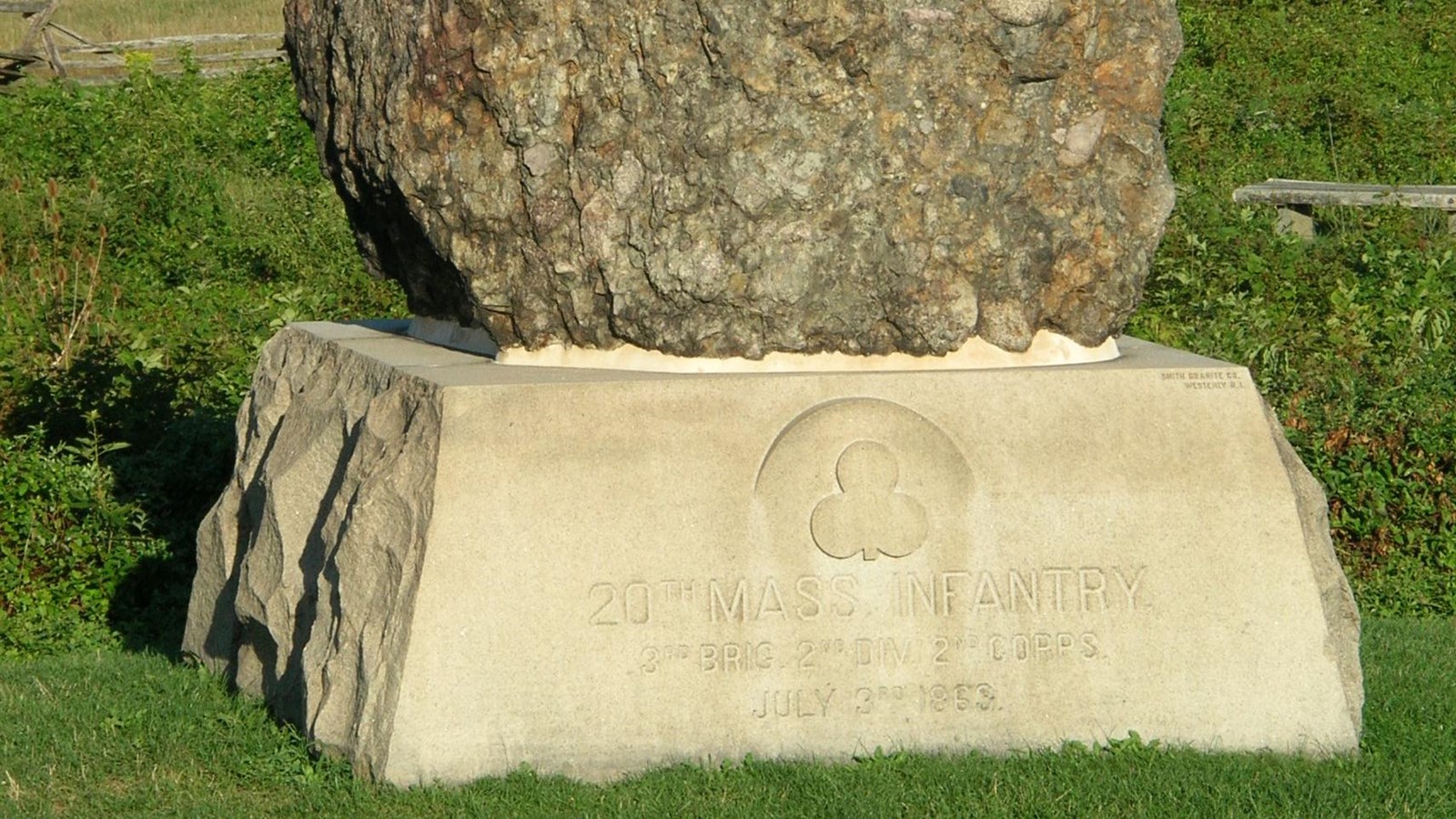Last updated: October 24, 2021
Place
20th Massachusetts Monument

Quick Facts
Location:
Gettysburg National Military Park
Significance:
20th Massachusetts Monument
Designation:
Civil War Monument
This line of monuments marks the positions of Union infantry of General John Gibbon’s 2nd Division, 2nd Corps, and General Abner Doubleday’s 3rd Division, 1st Corps, on July 3. Each Union army corps had adopted a patch which the men generally wore on their hats. The symbol for the 2nd Corps was a trefoil. This corps occupied Cemetery Ridge on July 2 and July 3 which is why you will see many trefoils on monuments along the ridge.
One of the more unique monuments along this line honors the 20th Massachusetts Infantry. The 20th had the nickname “The Harvard Regiment,” because a number of their officers were graduates of Harvard College. The regiment’s colonel was Paul Joseph Revere, the grandson of Paul Revere. He was killed by artillery fire on the afternoon of July 2. Among its lieutenants was Sumner Paine, a great grandson of a signer of the Declaration of Independence. Paine was killed during the repulse of Pickett’s Charge. The monument consists of a 30-ton pebbledconglomerate rock known as “Roxbury puddingstone,” named for the town of Roxbury, Massachusetts. The idea for the monument came from some members of the regiment from Roxbury who, as children, had played on such boulders. In 1983, the “Roxbury puddingstone” became the official rock of the state of Massachusetts.
The men of the 20th and the regiments around them endured the artillery bombardment before Pickett’s Charge as best they could. On the night of July 2, with a single shovel shared by the men, the regiment dug what one described as “a slight rifle-pit, a foot deep and a foot high.” This afforded the men some shelter from the artillery fire, but since most of the Confederate shells were directed at the Union artillery or overshot the ridge, losses were light. When the Confederate infantry advanced, the Union soldiers allowed them to come close before opening fire. Captain Henry Abbott, serving with the 20th, described the fighting in the after-action report of his regiment:
“After the cessation of the enemy’s artillery fire, their infantry advanced in large force. The men were kept lying on their bellies, without firing a shot, until orders to fire came from Colonel Hall, commanding the brigade, the enemy having got within 3 or 4 rods of us [15 to 20 yards], when the regiment rose up and delivered two or three volleys, which broke the rebel regiment opposite us entirely to pieces, leaving only scattered groups.”
Another soldier in the 20th Massachusetts:
“From the moment that the men of the Twentieth commenced firing, the smoke was so thick that little could be seen, but there was no trouble in making it effective, for not less than three thousand men formed a vast crowd in front. The noise and turmoil were such that commands could not be heard, and every one fought in his own way.”
Although the men along this part of the Union line checked the Confederate infantry in their front, the Confederates to the right had greater success and managed to pierce the Union line. Our next stops will take us to this area.
One of the more unique monuments along this line honors the 20th Massachusetts Infantry. The 20th had the nickname “The Harvard Regiment,” because a number of their officers were graduates of Harvard College. The regiment’s colonel was Paul Joseph Revere, the grandson of Paul Revere. He was killed by artillery fire on the afternoon of July 2. Among its lieutenants was Sumner Paine, a great grandson of a signer of the Declaration of Independence. Paine was killed during the repulse of Pickett’s Charge. The monument consists of a 30-ton pebbledconglomerate rock known as “Roxbury puddingstone,” named for the town of Roxbury, Massachusetts. The idea for the monument came from some members of the regiment from Roxbury who, as children, had played on such boulders. In 1983, the “Roxbury puddingstone” became the official rock of the state of Massachusetts.
The men of the 20th and the regiments around them endured the artillery bombardment before Pickett’s Charge as best they could. On the night of July 2, with a single shovel shared by the men, the regiment dug what one described as “a slight rifle-pit, a foot deep and a foot high.” This afforded the men some shelter from the artillery fire, but since most of the Confederate shells were directed at the Union artillery or overshot the ridge, losses were light. When the Confederate infantry advanced, the Union soldiers allowed them to come close before opening fire. Captain Henry Abbott, serving with the 20th, described the fighting in the after-action report of his regiment:
“After the cessation of the enemy’s artillery fire, their infantry advanced in large force. The men were kept lying on their bellies, without firing a shot, until orders to fire came from Colonel Hall, commanding the brigade, the enemy having got within 3 or 4 rods of us [15 to 20 yards], when the regiment rose up and delivered two or three volleys, which broke the rebel regiment opposite us entirely to pieces, leaving only scattered groups.”
Another soldier in the 20th Massachusetts:
“From the moment that the men of the Twentieth commenced firing, the smoke was so thick that little could be seen, but there was no trouble in making it effective, for not less than three thousand men formed a vast crowd in front. The noise and turmoil were such that commands could not be heard, and every one fought in his own way.”
Although the men along this part of the Union line checked the Confederate infantry in their front, the Confederates to the right had greater success and managed to pierce the Union line. Our next stops will take us to this area.
